Cascadia Research will be undertaking a field project off the island of Kaua‘i in early August. This will be our 16th field project working off Kaua‘i, and our 11th year of working off the island since our first trip here in 2003 (our last field project off Kaua‘i was in August 2017). This project is funded by U.S. Pacific Fleet through the Marine Species Monitoring Program and by a grant from the Pacific Islands Fisheries Science Center.
There are two main objectives of the project. The first is to try to obtain information on movements and behavior of a number of species of toothed whales before, during and after a Navy Submarine Command Course, through the deployment of depth-transmitting satellite tags. Some of the tags we will be using also have Fastloc GPS capability, giving us much more accurate movement information than normally obtained by Argos tags. Such tag deployments give us information on movement patterns as well as exposure and potential responses to mid-frequency active sonar (MFAS). This is a continuation of work we’ve been undertaking the last few years, and reports on MFAS exposure and response of several species of whales and dolphins are available for February 2011 through February 2013 and August 2013 through February 2015.
The second main objective is to find and learn more about the endangered main Hawaiian Islands insular population of false killer whales, to help understand seasonal and inter-annual variation in movement patterns. As we do during all of our field projects, we will also be obtaining photos from most species of odontocetes we encounter, to contribute to ongoing studies of residency patterns and social organization and to estimate population sizes, and collecting biopsy samples for toxicology and genetic studies. We also have a small number of tags provided through a grant from Dolphin Quest that we may deploy on species such as rough-toothed dolphins or bottlenose dolphins, that aren’t a priority for the Navy-funded effort.
Like other projects off Kaua‘i in recent years we expect to have higher encounter rates than normal since we’ll be working in collaboration with the Marine Mammal Monitoring on Navy Ranges (M3R) program, using the Navy’s hydrophone range off Kaua‘i (see map below) to localize animals. When on the water we will be in constant contact with Navy researchers from the M3R program to help direct us to groups that they are detecting acoustically. This will allow us to confirm the species (to aid in using the acoustic range for research purposes on different species), and should make it much easier for us to find groups of whales and dolphins for tagging, photo-ID and biopsy sampling.
Species that we are hoping to satellite tag include false killer whales, short-finned pilot whales, melon-headed whales, pygmy killer whales, bottlenose dolphins, rough-toothed dolphins, sperm whales, Cuvier’s beaked whales, and Blainville’s beaked whales.
The research team includes Daniel Webster, Colin Cornforth, Jordan Lerma, Brittany Guenther, Robin Baird and a number of volunteers.
End of project update

August 20th was our last day on the water. Over the 15 days we covered 1,604 kilometers (997 miles), had 58 encounters with seven species of odontocetes, collected 18 biopsy samples (from five species), and deployed eight satellite tags (six of the Fastloc GPS tags, one depth-transmitting tag, and one location-only tag). Overall a very successful project. In the last few days we encountered three (or possibly four- we need to compare photos) groups of pilot whales on three different days, and were able to deploy Fastloc GPS tags on both groups, and are obtaining both GPS locations and dive data from both groups. The photos above of two spyhopping short-finned pilot whales shows one individual with some sort of debris in the mouth (we’ll be looking at other photos of this individual to see if we can identify what the material is).

An adult male short-finned pilot whale off the south shore of Kaua’i, with a second adult male in the distance.

One group of pilot whales encountered on August 17th also had a number of melon-headed whales mixed in with the group, including this mother and newborn (evident by the fetal folds on the side of the calf)
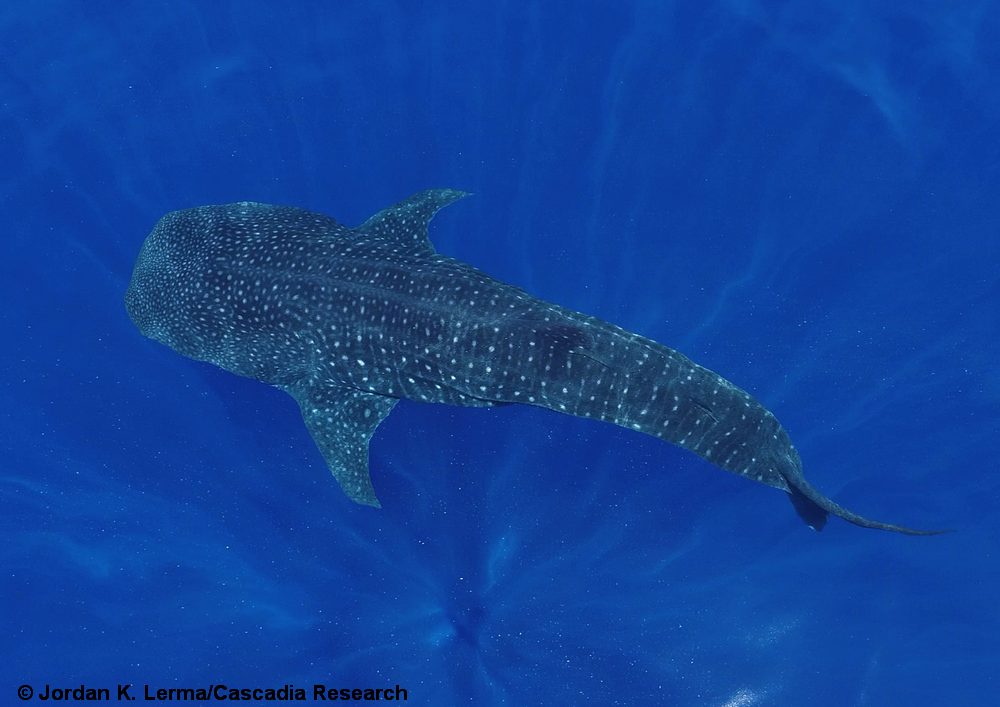
One of the highlights of the trip (at least for the crew!) was the sighting of a whale shark on August 18th. We contribute photos of any whale sharks we encounter to Hawai’i Uncharted Research Collective for their whale shark catalog.
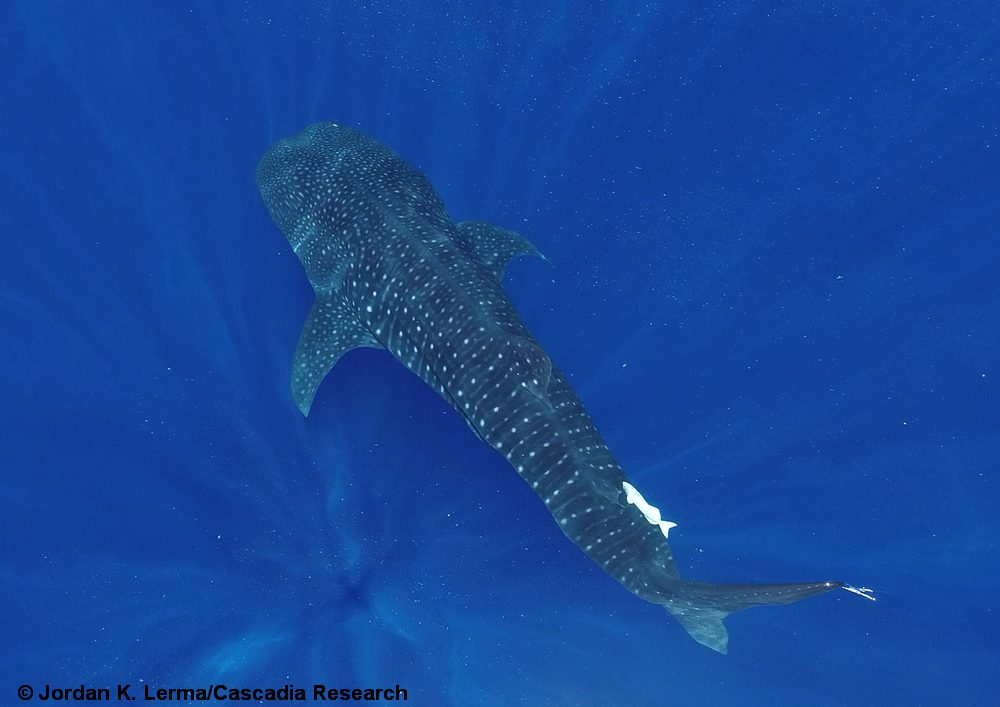
This aerial image of the whale shark, taken from a drone, shows a large remora near the tail.
Follow our vessel tracks on the water
Although we only started using it part way through this project (thus the tracklines you can see are incomplete) we now have live tracking of our vessel location. You can click on the “tracks” arrow to the left to see the tracklines for individual days. Using the layers button (looks like a stack of papers) you can also select Aerial to see bathymetry associated with the vessel tracks.
August 16th update

We had two new species for the trip on August 16th (bringing our total up to six), both relatively rarely seen species for this area. The photo above (and the two below) are of an adult male sperm whale, part of a dispersed group first detected acoustically using the hydrophones on the range. This individual has a very large and unusual wound below the dorsal fin. While there are a number of linear marks in the wound consistent with a propeller strike, the localized area of the wound makes it difficult to envision how a propeller could have just hit that one area.

The adult male sperm whale with Lehua in the background.

The adult male sperm whale fluking with Ni’ihau in the background.

The other equally unusual species for the area was a group of pantropical spotted dolphins. While this species is resident off the other main Hawaiian Islands, it is rarely seen off Kaua’i or Ni’ihau – this was only our 12th encounter with this species off Kaua’i in our 11 years of working here (and four of the 12 encounters were just with a single individual seen repeatedly in 2005 and 2011). From a previous study of genetics as well as results from satellite tagging of this species in 2016 and 2017, spotted dolphins off this island appear to be part of an open-ocean population that just moves through the area, rather than a resident, island-associated population like some of the other species in the area. We were able to collect four biopsy samples for genetics, with the hopes of confirming this is a pelagic group.

An adult pantropical spotted dolphin seen August 16th. For more information on this species in Hawai’i check out our spotted dolphin web page

A bottlenose dolphin leaping off the south shore of Kaua’i, along with a Wedge-tailed Shearwater, August 12, 2018

A rough-toothed dolphin under our research boat, taken with a GoPro over the side of the boat.
August 11th update

Over the last couple of days the winds have started to subside a bit and we’ve been able to survey in deep waters west of the island. We have had a number of additional sightings of rough-toothed dolphins, including the individual above foraging in association with Wedge-tailed Shearwaters, and have been able to get good identification photos of a number of individuals.


One of the rough-toothed dolphin groups included a newborn calf, evident by both the small size and by the fetal folds (creases in the skin from the folding of the calf in utero).

We also encountered a group of spinner dolphins that included two newborn calves.
August 9th update
Day four on the water today. Despite relatively strong winds, with Hurricane Hector passing far to the south and increasing winds a bit around the islands, we had several good encounters with rough-toothed dolphins, and were able to deploy a LIMPET satellite tag on one individual, as well as collect three biopsy samples. Four days into the project we’ve encountered four species of odontocetes, and the folks monitoring the Navy’s hydrophone system have also heard sperm whales, and probably Bryde’s whales, northwest of Kaua’i. We are hoping that as the hurricane passes calmer winds may prevail, allowing us to get back out into deep water.

A rough-toothed dolphin off Kaua’i, August 9, 2018. The area around Kaua’i may be the best area in the world to see this species, with a large resident population. We will be comparing the photos to our catalog to see who these individuals are and whether they have been previously documented off the island.


A melon-headed whale (left) and a rough-toothed dolphin (right), seen August 7th.
August 7th update
Today was our second day on the water for the trip, and thanks to a call from Captain Andrew from Seasport Divers we had a great encounter with a group of melon-headed whales. In the 11 different years of work off this island this is only the third year we’ve seen melon-headed whales off the island (our previous sightings were in June/July 2008 and August 2017). Today’s group was about 150 individuals, with six or so rough-toothed dolphins mixed in. We were able to deploy two depth-transmitting Fastloc GPS satellite tags on melon-headed whales, the first GPS tags deployed on this species. We are looking forward to tracking the movements and behavior of this group and hoping to be able to encounter them again over the next two weeks.

A melon-headed whale rolling at the surface during a social interaction, August 7, 2018.

Melon-headed whales socializing off Kaua’i, August 7, 2018

A melon-headed whale with a Fastloc GPS satellite tag on the dorsal fin, deployed August 7, 2018
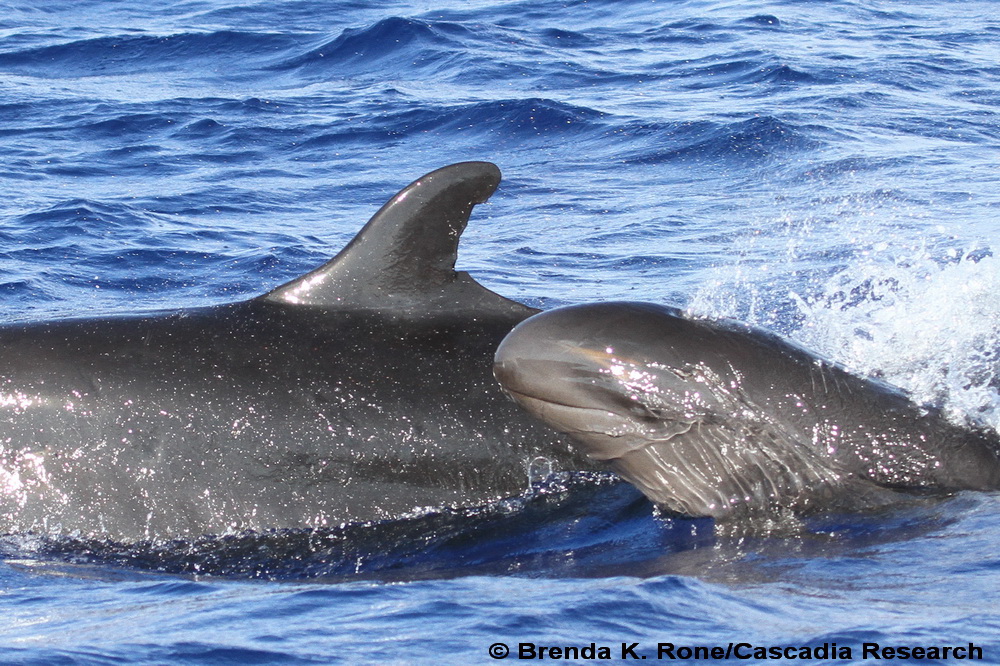
One of the species we hope most to see this trip, false killer whales. These individuals were seen off Kaua’i during our September 2015 project and are part of the Northwestern Hawaiian Islands population.
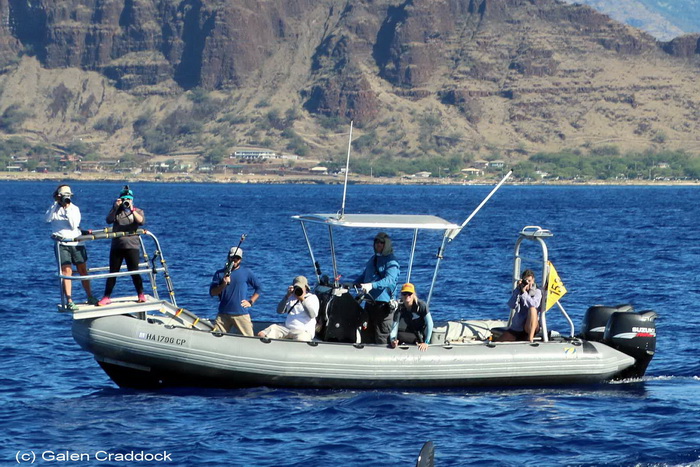
Our research vessel for this project, a 24’ rigid-hulled Zodiac
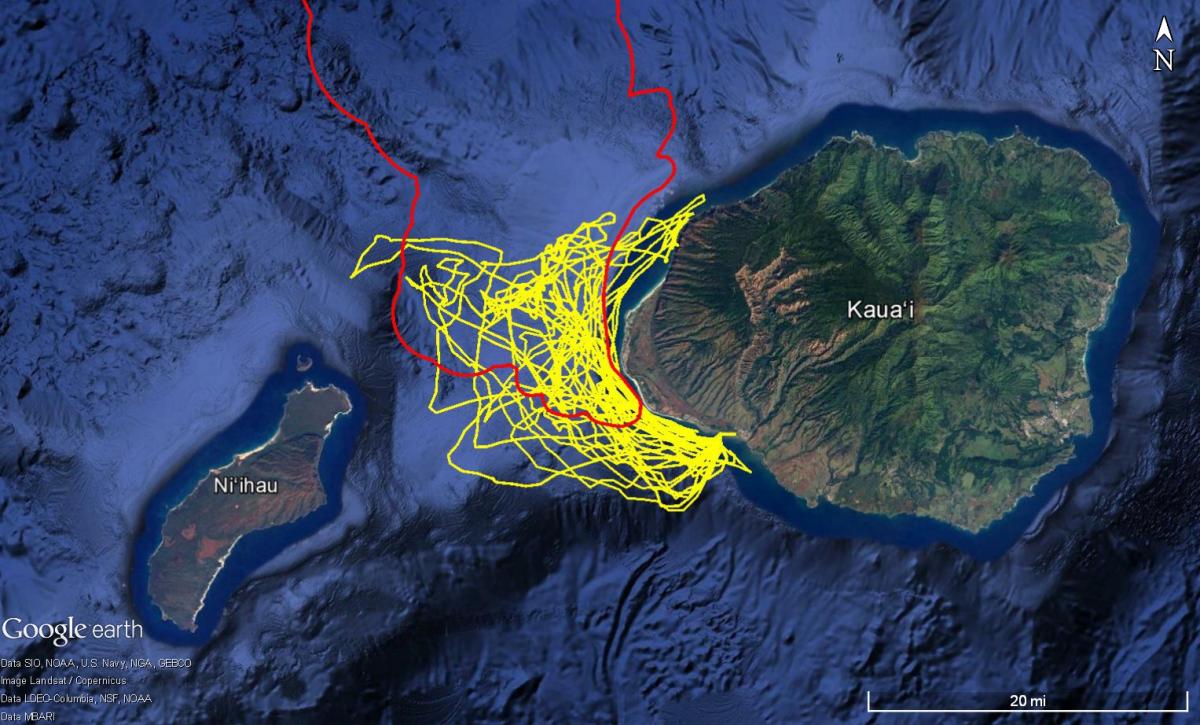
This map shows our vessel tracklines (yellow) for previous field projects during the month of August. The Pacific Missile Range Facility (PMRF) boundary is shown in red. Inside this boundary are >150 bottom-mounted hydrophones that can be used to help direct our research vessel to vocalizing cetaceans.
Photos on this page were taken under NMFS Permit No. 20605. Contact Robin Baird (rwbaird “at” cascadiaresearch “dot” org) for more information
For more information on our research follow us on Facebook